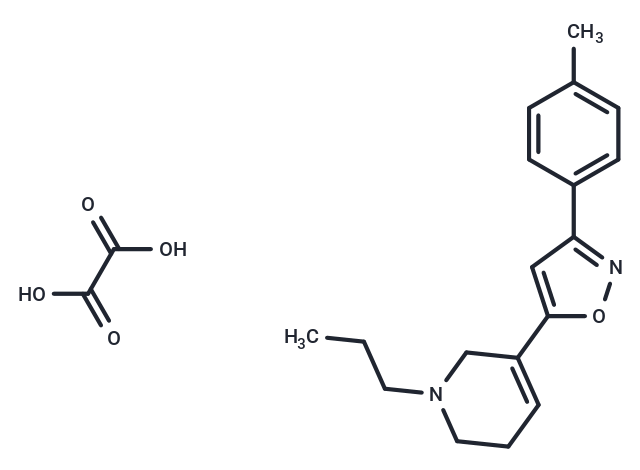Shopping Cart
- Remove All
 Your shopping cart is currently empty
Your shopping cart is currently empty

PD 144418 oxalate is a highly potent and selective sigma 1 (σ1) receptor ligand with a Ki value of 0.08 nM for σ1 and 1377 nM for σ2, exhibiting negligible affinity for other receptors, ion channels, and enzymes, and demonstrating potential antipsychotic activity.

| Pack Size | Price | Availability | Quantity |
|---|---|---|---|
| 1 mg | $54 | In Stock | |
| 5 mg | $135 | In Stock | |
| 10 mg | $196 | In Stock | |
| 25 mg | $338 | In Stock | |
| 50 mg | $492 | In Stock | |
| 100 mg | $719 | In Stock | |
| 200 mg | $987 | In Stock |
| Description | PD 144418 oxalate is a highly potent and selective sigma 1 (σ1) receptor ligand with a Ki value of 0.08 nM for σ1 and 1377 nM for σ2, exhibiting negligible affinity for other receptors, ion channels, and enzymes, and demonstrating potential antipsychotic activity. |
| Targets&IC50 | σ1 receptor:0.08 nM (Ki), σ2 receptor:1377 nM (Ki) |
| In vitro | In vitro, PD 144418 counteracts the increase in cyclic GMP (cGMP) triggered by N-methyl-D-aspartate (NMDA) in rat cerebellar slices, without altering basal levels. This implies a significant role for σ1 sites in controlling actions induced by glutamine. Furthermore, PD 144418 enhances the reduction of 5-hydroxytryptophan induced by Haloperidol within the mesolimbic region, although it does not independently affect 5-HT and dopamine (DA) synthesis [1]. |
| In vivo | Treatment with PD 144418 (10 mg/kg; intraperitoneal injection; male CD-1 mice) effectively antagonized Mescaline-induced scratching without affecting spontaneous motor activity, displaying an ED 50 of 7.0 mg/kg (i.p.). This outcome was observed in a study where male CD-1 mice were administered a single intraperitoneal dose of 10 mg/kg, resulting in the inhibition of scratching behaviors induced by Mescaline. |
| Molecular Weight | 372.42 |
| Formula | C20H24N2O5 |
| Cas No. | 1794760-28-3 |
| Smiles | O=C(O)C(=O)O.N=1OC(=CC1C=2C=CC(=CC2)C)C3=CCCN(C3)CCC |
| Storage | Powder: -20°C for 3 years | In solvent: -80°C for 1 year | Shipping with blue ice. | |||||||||||||||||||||||||
| Solubility Information | DMSO: 10 mg/mL (26.85 mM), Sonication is recommended. | |||||||||||||||||||||||||
Solution Preparation Table | ||||||||||||||||||||||||||
DMSO
| ||||||||||||||||||||||||||

Copyright © 2015-2025 TargetMol Chemicals Inc. All Rights Reserved.